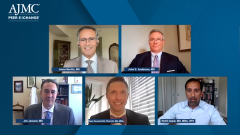
Identifying Unmet Needs Surrounding Patients With Heart Failure
The panel of experts provide their final insights regarding unmet needs surrounding treatment management of heart failure.
Episodes in this series

Ryan Haumschild, PharmD, MS, MBA: Thanks to all of you for this rich and informative discussion. Before we conclude, I’d like to get final thoughts from each of you. Dr Murillo, can we start with you on your final thoughts for our viewing audience?
Jaime Murillo, MD: Yes, thank you for the opportunity to discuss the population health approach to management of heart failure, which is a critical group of patients we have. If you think about the United States population, the fact that more than 50% of the population are theoretically at risk for heart failure places a major burden on us to move upstream. Now is the time for us to start thinking about how to best treat heart failure with guideline-directed medical therapy, and how we can get more proactive and identify those who are at risk of having heart failure and those who are considered in pre-heart failure. Can we optimize strategies to identify those patients with better testing? What are the populations at risk? How can we best utilize our data to risk stratify patients in a better way to prevent them from going into stage D heart failure?
It’s essential and vital for us to approach heart failure in a more optimal way than we have so far, beyond the purely clinical considerations to treating heart failure. The key to our success is how we see a patient within their own environment and how we can approach that patient with their own needs beyond the prescriptions.
Ryan Haumschild, PharmD, MS, MBA: Excellent thought: risk stratification, early detection, and team-based care. Dr Anderson, your final thoughts for us?
John E. Anderson, MD: Thanks. This has been a great discussion. When I look back over the course of my career at where we started and where we are now with heart failure, we have almost an embarrassment of riches in terms of tools and therapies we never had before. But that also comes with an increased complexity, particularly in the primary care world, where you’re managing multiple different disease states and comorbidities. Education is critical to make sure everybody understands what guideline-directed therapy looks like.
Finally, we have to tear down the silos. So many of these cardiorenal metabolic patients cross all of these therapeutic options that we can no longer be the person who only treats the glucose or only treats the blood pressure. When you enter the examination room and the patient is sitting in front of you, what do they need? What are they lacking? What communication do you need to make it happen?
Ryan Haumschild, PharmD, MS, MBA: Excellent thoughts. Dr Uppal, how do you want to finish us out with some of your final thoughts from today?
Rohit Uppal, MD, MBA, SFH: Those are great final thoughts. People stole my thoughts as well. It’s incredible how many times team-based care and breaking down silos came up today. Here we are on a call where we have a pharmacist facilitating a conversation that includes a primary care doctor, a hospitalist, and a cardiologist. Those are the kinds of conversations we need to be having. In the course of this conversation, we’ve covered so much ground and made so much progress. We need these kinds of conversations happening at the community and hospital level. That’s how we break down those silos. I’m happy to have been part of this. Thank you.
Ryan Haumschild, PharmD, MS, MBA: Thank you. And Dr Januzzi, we want to leave with some final thoughts from you.
Jim Januzzi, MD: There’s nothing else to say. This has been a great discussion. My colleagues have covered all the high points. It’s useful and important to know why we do the things we do, but it’s critically important to learn how to do the things we do. To simplify things, we’ve got reduced, mildly reduced, and preserved ejection fraction. The treatments are largely the same across those different categories. What’s more important is how to get the medication started, how to get the medications titrated, working as a team, and learning how to use these medications. Because with the growing tide of heart failure in the health care system, it’s all hands on deck. Everyone needs to know how to use these therapies and apply them effectively in order to reduce the risk for our patients.
Ryan Haumschild, PharmD, MS, MBA: Thank you all again for this great discussion. And to our viewing audience, we hope you found this AJMC® Peer Exchange discussion to be useful and informative.
Transcript edited for clarity.
Newsletter
Stay ahead of policy, cost, and value—subscribe to AJMC for expert insights at the intersection of clinical care and health economics.








































